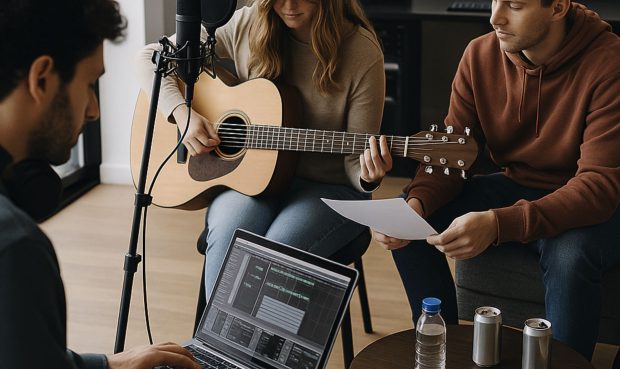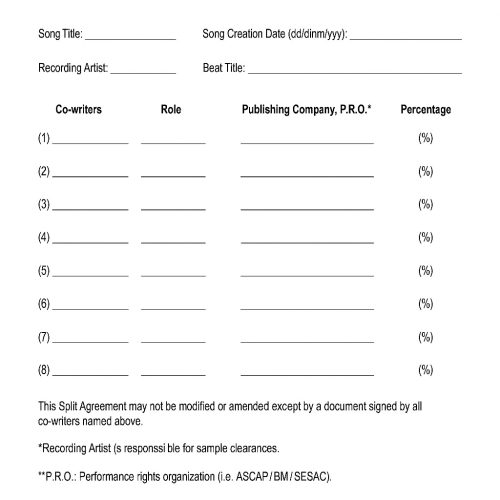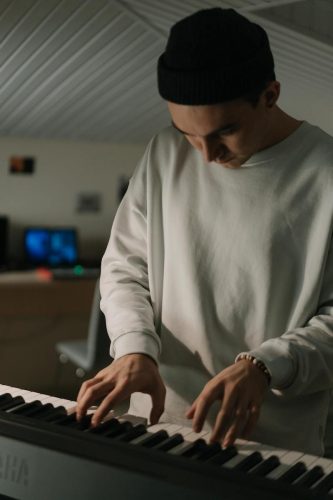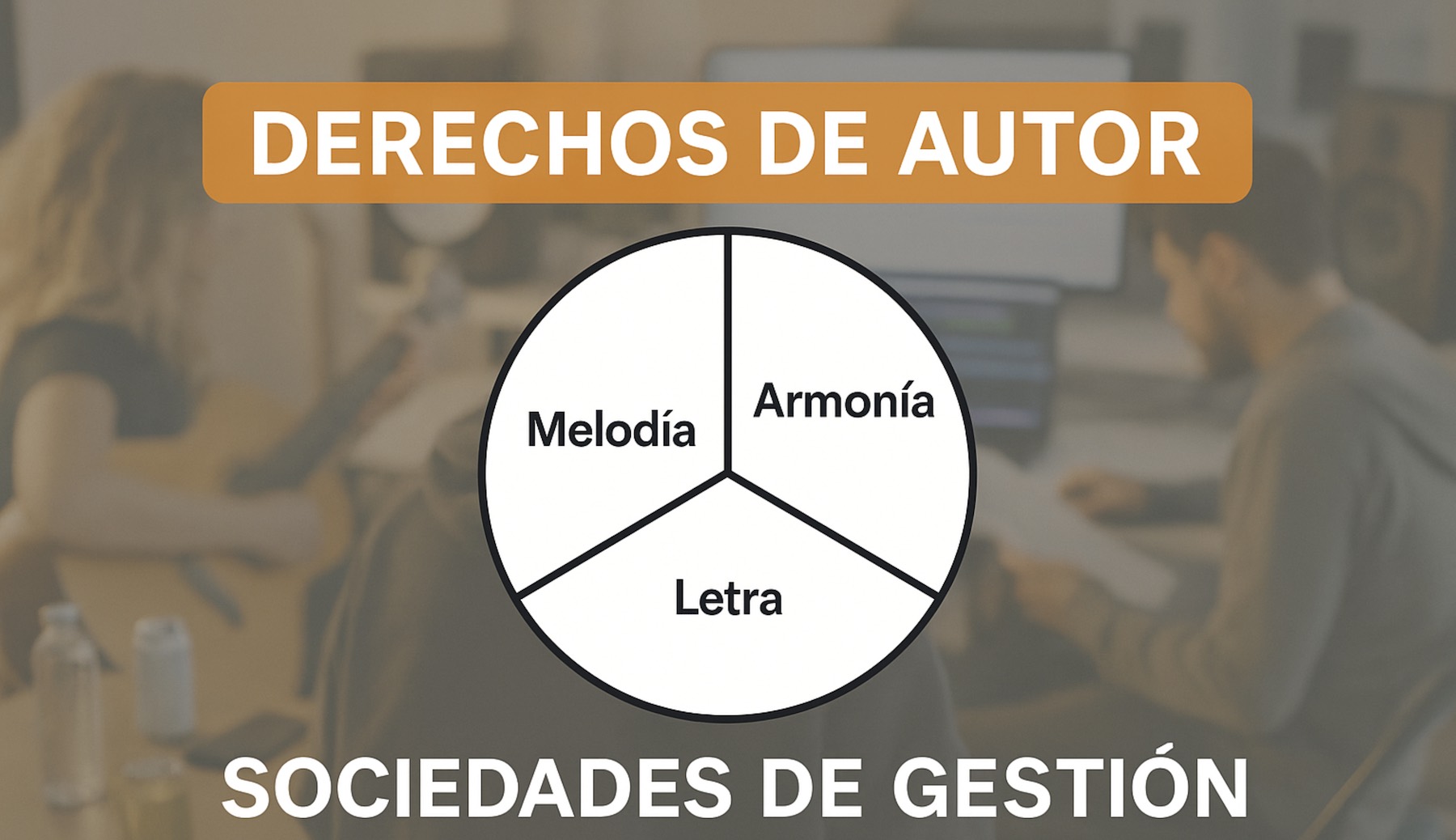How are a song’s copyrights divided?
When we talk about song copyrights, one of the most common questions among musicians and producers arises: How should they be divided among composers, lyricists, and producers? Traditionally, it’s split 50% for music and 50% for lyrics, but at GuitarRec we believe this model is outdated and doesn’t reflect the creative reality of a modern musical work.
The traditional split: 50% music, 50% lyrics
The classic system divides the rights into two halves: music gets 50% and lyrics the other 50%. This simplistic approach doesn’t consider that music is much more than just the melody: it includes harmony, chords, the beat, and the overall sound structure. That’s why many artists and producers today seek a fairer and more balanced split.
Modern proposal: 33.3% for harmony, melody, and lyrics
For some time now, there’s been a more balanced way of understanding composition. It involves making a three-way split in equal parts:

- 33.3% harmony: Refers to the chord progression and overall harmonic structure, fundamental for defining the atmosphere and emotional character of the song. If we start from creating a beat, this usually includes the chord harmony.
- 33.3% melody: The main vocal or instrumental line that serves as the most identifiable and memorable element.
- 33.3% lyrics: To be shared among those contributing to the lyrical part of the song.
This approach acknowledges the creative value of each element and encourages more transparent agreements among artists, especially in modern collaborations where producers and beatmakers contribute far more than just simple accompaniment.
Another way to split song copyrights during songwriting sessions, very common in writing camps, is to divide equally among everyone present. This is justified because everyone contributes to the overall mood or artistic vibe that shapes the song, regardless of their specific task. But this can be more delicate if someone truly carries the weight of creating one of the main elements mentioned above or brings in a more developed initial idea.
The importance of agreeing: the Split Sheet
To avoid future conflicts, it’s essential to put everything in writing with a Split Sheet. This document details the percentage assigned to each collaborator from the very beginning. It’s signed by the authors, lyricists, producers, and any other participant contributing creatively. Without a Split Sheet, claiming rights becomes an ambiguous and dangerous territory.

Pro tip: Just as you should make sure that the percentages are clear, it’s also crucial not to fight over small percentages in bands or groups. It’s very common for each band member to receive something from every song composed; you can agree on a minimum. Throughout history, there have been countless arguments and misunderstandings over rights that, in practice, haven’t generated a single euro. It’s not worth it. Keep in mind that for a song to generate significant copyright revenue, it needs to have strong impact and remain active on radios, live shows, and other channels for a long time.
Where to register a song?
Registering your song is essential to protect your work and ensure royalty collection. However, it’s important to clarify that registering copyright with a collective management organization (like SGAE) does not protect your song from potential plagiarism nor does it fully certify intellectual property ownership. What it does is manage the collection and distribution of economic rights generated, for example, on TV, radio, film, and gradually on streaming platforms.
If your main goal is to protect authorship and prove original creation against third parties (for example, in case of plagiarism), you should use additional methods such as registering with the Intellectual Property Office or through legally valid online deposit services.
In summary, you can register your song at:
- Collective management organizations such as SGAE (Spain), ASCAP (United States), SACM (Mexico), among others. (for copyright management, not intellectual property protection or legal registration against potential plagiarism)
- To protect the ownership of the song, our blog features a specific article on registering songs online.
The producer’s role: do they have copyrights?

A common mistake is to think that the producer only contributes technically. However, if the producer creates the beat, designs chords, or changes the musical structure, they are actively participating in the musical composition. According to our proposal, the producer should have at least 33.3% if they handle the musical harmony (the song’s chords).
Many singers believe that the song is entirely theirs because they wrote the melody and lyrics, but the chords (harmony) radically change the vibe and direction of the song. That’s why it’s crucial to acknowledge the producer’s creative contribution. Of course, if the composer has already created a harmonic base, like a chord progression on guitar or piano, or even a bass line, in that case, it is considered that they have already composed the harmony. It’s always important to analyze the situation carefully and reach a fair agreement based on each person’s actual contribution to the musical composition.
The role of the arranger
If a producer or musician adds intros, additional riffs in any section of a song, or complementary melodies, they may be listed as an arranger with the collective management organization. In SGAE, the maximum percentage for an arranger is 16.6%. Important: the arranger is not an author and has no decision-making rights regarding the use of the song.
Difference between copyrights and performance (neighboring) rights
It’s crucial not to confuse copyrights with performance or neighboring rights. Copyrights belong to composers and lyricists and cover the economic and moral exploitation of the original work (for example, payment for its use on radio, film, or digital platforms).
On the other hand, performance rights or neighboring rights are for performers and session musicians who provide the recorded interpretation but don’t necessarily participate in the composition. In Spain, these rights are managed mainly by AIE (Artistas Intérpretes o Ejecutantes). This means that a singer or musician can collect neighboring rights for performing a song, even if they didn’t write the music or lyrics.
In short, copyrights protect the intellectual creation of the work, while neighboring rights compensate those who perform and bring the work to the audience.
Recommended: check our article on music contracts to learn more about the different types of rights and agreements with publishers to collect them.
How do we work at GuitarRec?
At GuitarRec, when we produce for artists online, we always request a demo with the song sung and played on an instrument. This ensures that the work is 100% composed by the client before starting music production either in person or online. This way, authorship always belongs to the artist or songwriter.
Still, in some cases, it’s possible to agree on a small percentage (10% or 15%) as arrangers if the artist wants us to add musical arrangements and extra melodies to enhance the song, not just professionally record and instrument it. This is especially true when the starting point is simply an instrument and voice rather than a demo with a defined direction.
Learn more here about our online music production service for songwriters and artists.
Conclusion: towards a fair and updated split
The music world has evolved, and the 50/50 model no longer reflects today’s creative reality. Recognizing harmony as an independent compositional pillar and splitting into three equal parts (33.3%) can encourage healthier and more transparent collaborations. Documenting everything with a Split Sheet and properly registering the work are essential steps to avoid conflicts and protect your rights.







